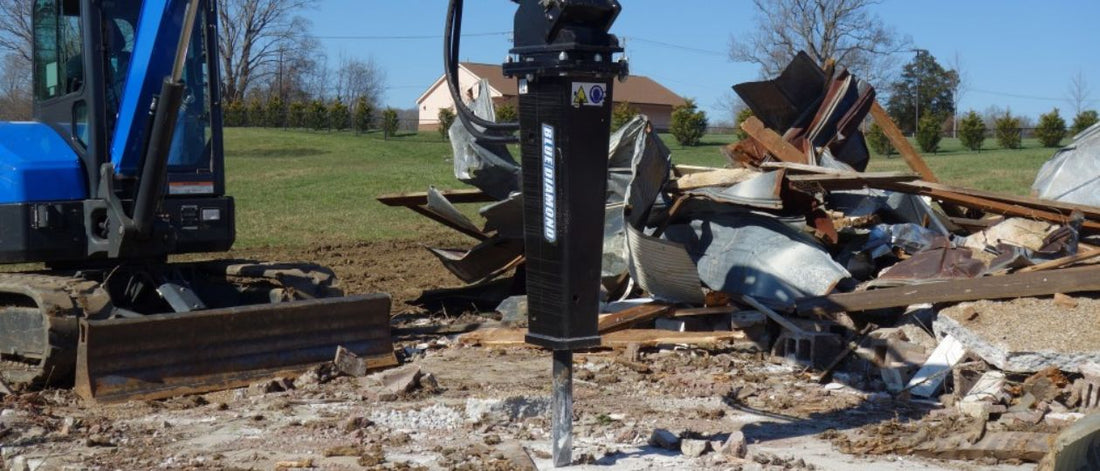
Best Hydraulic Hammer for Mini Excavator
Share
Choosing The Best Hydraulic Hammer For Your Mini Excavator
Hydraulic hammer, also known as demolition hammer or a hoe ram, is usually used for excavation and demolition projects. It is a robust attachment for excavators for demolishing concrete structures or rocks. It can be mounted on excavators and other carriers like skid steer loader, backhoe loader, wheel loader, mini-excavator, and other machinery.
Key Takeaways
- The best quality mini excavator hammers are Montana Breakers.
- Montana Breakers have the highest power-to-weight ratio for mini excavator hammers.
- Blue Diamond’s mini excavator hammer requires the lowest maintenance among hydraulic hammers.
Montana Breakers - Best All Around Hammer
At the time of writing, Montana Breakers are the most popular mini excavator breaker brand in America. I personally prefer them. They have done an excellent job of keeping the breaker simple and prioritizing quality.
|
Best Overall Mini Excavator Concrete Breaker

|
Excavator Hydraulic Breaker Hammer by Montana |
|
Power-To-Weight Ratio
As a starting point, I always like to compare the power-to-weight ratio of hydraulic breakers. The more power a breaker has for its weight, the better it generally is.
To make this calculation, I divide the energy class of the hammer by its working weight. The higher the result, the higher the power-to-weight ratio.
Impressively, Montana’s two smallest mini excavator hammers have a power-to-weight ratio greater than 1.
For example, the MB0300-EX model has an energy class of 230 and a weight of 225 lbs, giving it a power-to-weight ratio of 1.02.
To put this into perspective, similar size breakers of other brand names will often be quite underpowered compared to their weight, with power-to-weight ratios of 0.75 to 0.9 being fairly common.
Sturdiest Block
The block of a hydraulic breaker is the outer housing. Because every component of a hydraulic breaker lives inside the block, it’s important that the block is extremely sturdy.
There may not be many moving parts inside a hydraulic hammer, but keeping everything straight and in alignment is very important, as even the slightest shift can cause all sorts of damage. This is a difficult task considering the heat and vibration that hammers generate.
Montana Breakers have created an extremely sturdy housing by simply adding thick steel gussets on the exterior of the block.
This is an easy detail to overlook; however, in my opinion, something as simple as these gussets can add years of service to a hydraulic hammer.
Who Is The Montana Breaker Right For?
To use a Montana Breaker, your excavator will need to weigh at least 1,700 pounds and have auxiliary hydraulic flow with at least 4 gallons per minute.
This low requirement means that pretty much anyone with a mini excavator can use a Montana Breaker. Some of Bobcat’s smallest mini excavators these days weigh 2600 pounds and have 5 gallons per minute of hydraulic flow.
Blue Diamond - A More Advanced Hammer
|
Best Mini Excavator Concrete Breaker

|
Excavator Hydraulic Breaker Hammer HB50-HB530 by Blue Diamond |
|
|
|
Best Large Excavator Concrete Breaker

|
Excavator Hydraulic Breaker Hammer HB530-HB3000 by Blue Diamond |
|
We have been selling Blue Diamond mini excavator hammers for years, so from experience, I can say that these are problem-free hammers.
Blue Diamond famously took 5 years to develop their mini excavator hammer. Although it looks like a normal hammer from the outside, on the inside, it’s been engineered to stand out from the rest.

A hydraulic breaker hammer has three significant components: back head (nitrogen chamber), cylinder assembly, and front head.
Back Head (Nitrogen Chamber). The backhead is the chamber where nitrogen is stored. When placed under high pressure, the nitrogen-filled chamber acts like a damper upon the return piston-stroke. It also serves as an impact enhancer when the piston travels down.
Cylinder Assembly. The cylinder assembly is the central part of a hydraulic breaker hammer. It essentially consists of a piston, a cylinder, and a control valve. There are only two moving parts in the hydraulic breaker hammer, and both are found in the cylinder assembly; the piston and the valve. The piston goes up and down and hits the tool while the valve rotates to control the path of the oil. It is where movement happens and where hydraulic power is generated.
Front Head. It is where the piston attaches with the chisel (or working tool). The chisel is set with bushes and pins, which are the parts that need to be replaced often. The front head reaches the working surface directly, and a box-type housing protecting it from wearing and leads to longer service life.

Option To Add Automatic Greasing System
Grease is the lifeblood of any hydraulic hammer. Without a steady supply of high-quality grease, any hydraulic hammer would be dead in a matter of a few hours.
Typically, hammers need to be greased every two hours with grease that can stand temperatures of nearly 200 degrees Celsius.
Given how sensitive hammers are to being greased, Blue Diamond has made their hammers compatible with automatic greasing systems.
Although this system has to be closely monitored, it is known to add to the life of a hydraulic hammer while reducing maintenance time and cost.

Who Is The Blue Diamond Hammer Right For?
Blue Diamond has engineered a hydraulic breaker for mini excavators that can maintain its power and efficiency indefinitely, and can remove maintenance worries and inefficiencies. If this is important to you, Blue Diamond is the right choice.
The minimum size excavator you’ll need to run a Blue Diamond hammer is 1,500 pounds with a minimum hydraulic auxiliary flow of 7 gallons per minute.
Ensure The Breaker Will Fit Your Mini Excavator
Regardless of what brand of hammer you decide on, it won’t mean much if it doesn’t fit your mini excavator.
So, once you’ve narrowed down the brand of hammer, consider the following factors as well:
Mini Excavator Weight
The weight of your hydraulic hammer compared to your excavator is very important. If the hammer is too heavy, you risk making the excavator unstable when the boom is fully extended.
Additionally, sometimes customers are tempted to purchase an overly large breaker because they figure the extra weight will help with breaking.
This is only true up to a point. At some point when the hammer is too large and powerful for the excavator, the hammer will start to pop the boom off the ground, reducing the amount of force transmitted to the concrete.
Hydraulic Oil Flow
Each hydraulic breaker has a published minimum and maximum hydraulic gallons per minute needed for safe operation. These numbers are easy to find; however, if you're unsure of what they are, be sure to call us.
Operating the hammer outside of these parameters will certainly damage it. To make matters worse, most manufacturers will consider this damage from “misuse” and not honor your warranty.
You can easily set the auxiliary hydraulic flow on most modern mini excavators, with some models even allowing you to store preset values to easily use the correct flow rate when you use your hammer.
In short, ensure your mini excavator can operate within the correct hydraulic flow range.
Mini Excavator Couplers
The hammer has to be able to attach to the mini excavator, and as we all know, mini excavators don’t come with universal couplers.
For this reason, they are often sold with “blank plates” where you can bolt the proper coupler onto it to fit your machine.
You’ll want to ensure you can get a coupler for your hammer. The easiest way to do this is to call us and let us source it for you.
Conclusion
If you are looking for a mini excavator hammer, I would strongly suggest you look at Montana Breakers as well as Blue Diamond. Both are highly credible American manufacturers that stand by their work with industry-leading warranties.
And above all, ensure the hammer you choose will fit your excavator. Call us today, and we can discuss what's best for you.

